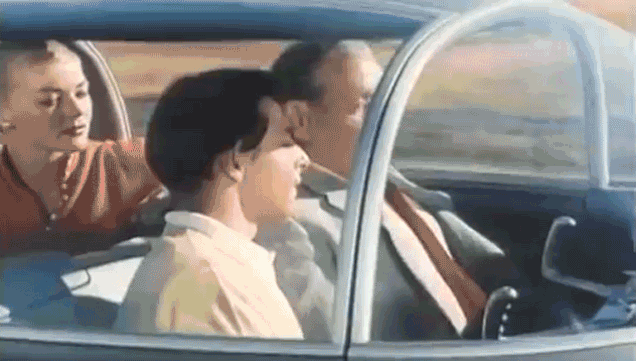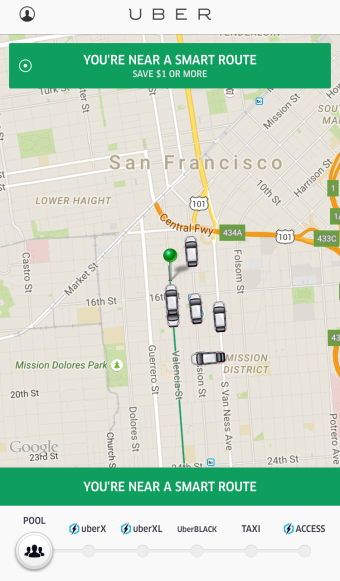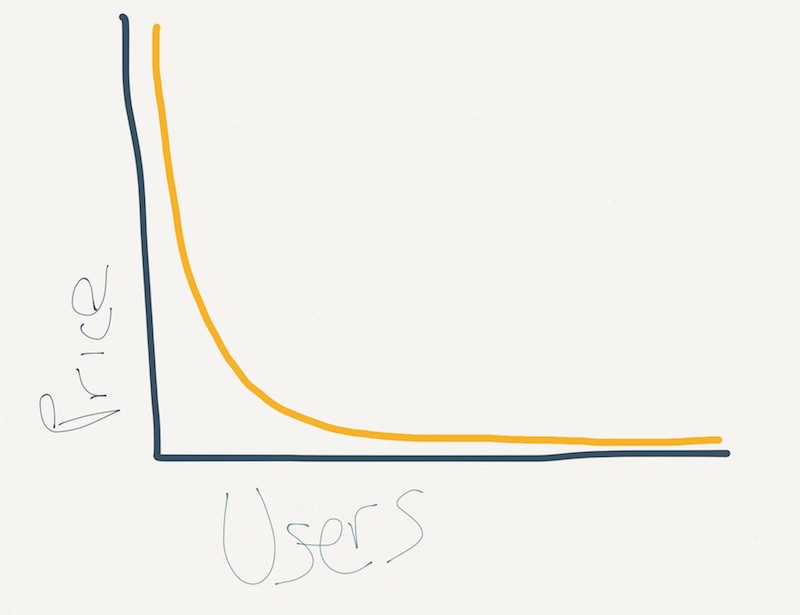The Uber Endgame

In San Francisco, Uber recently began testing what it calls “Smart Routes,” TechCrunch reports:
Rather than hailing an Uber directly to your door, UberPool’s map shows a green line overlaid on a major artery street nearby. If you’re willing to set your pickup location anywhere along these Smart Routes, Uber will compensate you with a discount of $1 or more off the normal UberPool price. In some cases that means walking a few blocks to your pickup spot. A little less convenient, a little cheaper.
Several weeks earlier, Uber began testing what it calls “Suggested Pickup Points”:
When dragging the pickup pin, the feature explains that passengers can “save time at these locations”, and shows places nearby where it would quicker for the driver to pick them up. Users can drop their pin on these green dots, see the address, and then walk there to shorten their wait time. … For example, at the San Francisco Giants’ AT&T; ballpark above, Uber suggests people head to one of the corners outside, rather than in the middle of the block where traffic rushes and there’s nowhere to pull over. If you’re in an one-way alleyway, Uber recommends you head out to the next main street.
And a few months ago, CEO Travis Kalanick mentioned something called a “Perpetual Trip” which would “allow drivers to pick up and drop off passengers continuously along the way,” taking its UberPool car-pooling service to its logical conclusion, an unbroken chain of rides.

TechCrunch’s Josh Constine compares Smart Routes to another “ride sharing service, Loup, which pays people to drive their cars and pick people up on bus-like routes through a city, and Chariot which does the same but with big vans.” But if you put all of these Uber innovations together — pre-determined routes with fixed pickup points and continuous passenger pickups — it sounds remarkably like a gently optimized version of currently existing mass transit, one of the services that Uber is attempting to d i s r xu p t. (It is telling though that Constine notes that one of Uber’s Smart Routes runs “up Fillmore St. from Haight St. to Bay St. in the Marina, which the Bay Area’s BART service doesn’t cover,” when the route is directly covered by the SF MUNI 22 bus, which runs every eight minutes according to Google Maps.) But it’s not surprising at all that Uber and Lyft continue to independently arrive at features that so closely resemble public transit that it seems like self-parody:
It turns out that mass transit is extremely efficient at moving around large quantities people and even, in some cases, getting them to “move past car ownership” en masse. What Uber and Lyft are building toward, in other words, is best understood as a privatized mass transit system built on top of public roads.
What’s remarkable, perhaps, is that for all of Uber and Lyft’s innovations, beyond a certain scale, they have yet to devise wholly unique or vastly differentiated solutions to the problems of moving people around in large cities. (This is not to downplay at all the enormous potential efficiencies of transit that is networked and dynamically responsive to rider demand, but only to point out that if public transit agencies were also beholden solely to people who own smartphones and mostly lived in relatively affluent areas, one could more easily imagine the MTA or Muni or the TLC making such upgrades.)
One of the more subtle underlying issues with the rise of Uber is the company’s slow siphoning of the political will to fix existing — or build new — public transit infrastructure in major cities. In Affluence and Influence: Economic Inequality and Political Power in America, Princeton Professor of Politics Martin Gilens shows that — as he put it in an article with Northwestern Professor of Decision Making Benjamin Page — “economic elites and organized groups representing business interests have substantial independent impacts on U.S. government policy, while mass-based interest groups and average citizens have little or no independent influence.” As the wealthy — and, as the prices of Uber and Lyft fall, the slightly less so — essentially remove themselves from the problems of existing mass transit infrastructure with Uber and other services, the urgency to improve or add to it diminishes. The people left riding public transit become, increasingly, the ones with little or no political weight to demand improvements to the system.
And if it seems unreasonable to imagine a scenario in which the mass adoption of Uber leads to a potential death spiral for public transit — and the true privatization of mass transit — in some cities, one need only consider how many public services have emerged and then been sustained precisely because they aligned with the particular vision of economic elites during a given time period. (For instance, in the case of Obamacare, the interests of the poor, who need universal healthcare, have become aligned with the rich, whose companies have, in recent years, increasingly relied on independent contractors or part-time labor rather than full-time employees to reduce costs and increase profits; Obamacare has effectively accelerated the erosion of the concept of full-time employment in its fulfillment of one of the the former social obligations of employers. Put another way, why hire an employee and pay for their healthcare and social security when you can hire an independent contractor and let the worker and the government split the cost?)
An exemplary case of Uber’s re-direction of the political will of its base was its total victory over Mayor Bill De Blasio’s hapless and deeply stupid campaign to limit the company’s growth in New York City — some of the final blows coming from celebrities (and even some business journalists!) tweeting messages written by Uber on its behalf. Would it be crazy to wonder what would happen if those same people mounted a similarly forceful campaign to get Governor Cuomo to clean out and fully fund the MTA to, say, make the L train less terrible?

The subtext of Uber’s new products having the look and feel of a slightly shinier version of mass transit is, of course, that Uber wants to be privatized mass transit. In Uber’s grand vision, no one owns cars because nearly everyone is taken everywhere in a driverless, electric, omnisciently networked Uber conveyance that arrives precisely when it is needed for a price cheap enough that for many people it feels free (but is just enough to make a profit, since one day, as unimaginable as it seems, the venture capital will run out). This is why Uber earnestly speaks of ending car ownership, taking cars off the road, and helping nurses commute to and from night shifts in the Bronx at two in the morning.

In general, the cheaper Uber is, the more mass it will become, and the more mass it becomes, the cheaper it can get — particularly once its cars have become driverless, as Kalanick predicts in the next fifteen years or so. This is how Uber transforms itself from a luxury to a basic, indispensable utility. But until Uber’s cars become driverless, it has at least one cost that is relatively fixed: labor. Uber must pay its drivers a living wage (or close enough to it). The fewer drivers that Uber must pay to meet increasing passenger demand — by putting more passengers in vehicles at once and minimizing gaps between rides — the more effectively it can hold down prices, fueling growth in both the number of users and the number of trips they are likely to take, making itself more and more integral in people’s lives. (Not incidentally, more efficiently packing each Uber vehicle makes surge pricing, which customers unduly loathe, less frequent, also encouraging people to use it more frequently.) This is why and how UberPool, Smart Routes, and perpetual rides work — and why and how Uber products have progressed, in the order that they have, from Uber Black to Smart Routes. (This is where a VC might point out that this is how all technological innovation works, trickling down from the elites to the masses.)
Let’s grant that Uber’s vision will come true. (It might!!!!!) While zero car ownership will undoubtedly and unremittingly be a net social good — can’t wait until driving is something one does for fun, ban cars! — and while perhaps nearly everybody will be able to afford Uber the Utility, what happens in the time between now and the Ubertopia? Capitalism may eventually provide everything for everyone (so we keep hearing!), but what about the people who can’t quite afford to Uber everywhere during the years when it costs more than public transit — which becomes broken and neglected as a large portion of the population effectively abandons it and no longer demands its maintenance, much less improvement? I suppose politicians could campaign on a platform for affordable Ubers — much like the price of putting up luxury housing in New York City these days, perhaps eighty percent of riders pay the market rate so that the twenty poorest percent need only pay what they can afford. It’d work better than De Blasio’s campaign to cap Uber, right?
Giph by Jalopnik; screenshot of Smart Routes by TechCrunch
